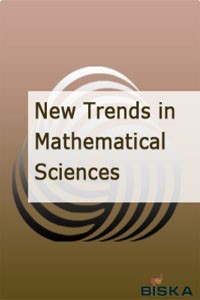Vibration analysis of a mass on a spring by means of magnus expansion method
Vibration analysis of a mass on a spring by means of magnus expansion method
Magnus Expansion Vibration, Free Damped Motion, Free Undamped Motion,
___
- Baye, D. & Heenen P.H. 1973. A theoretical study of fast proton-atomic hydrogen scattering. J Phys B: At Mol. Phys. 6: 105–13. Bialynicki-Birula I., Mielnik B. & Plebanski J. 1969. Explicit solution of the continuous Baker–Campbell–Hausdorff problem and a new expression for the phase operator. Ann. Phys. 51: 187–200.
- Blanes S. et al. 2009. The Magnus expansion and some of its applications, Physics Reports 470: 151-238.
- Blanes S. et al. 2014. Time-averaging and exponential integrators for non-homogeneous linear IVPs and BVPs. Applied Numerical Mathematics 62: 875-894.
- Blanes S. et al. 1998. Magnus and Fer expansions for matrix differential equations: the convergence problem. J. Phys. A 31: 259-268. Boyce W.E., DiPrima R.C., 2001. “Elementary Differential Equations and Boundary Value Problems”, John Wiley & Sons Inc, Singapore, pp. 200-205.
- Cady W.A. 1974. Rotational spectral line broadening of OCS by noble gases. J. Chem. Phys. 60: 3318–23.
- Castellano A. et al. 2014. Geometric numerical integrators based on the Magnus expansion in bifurcation problems for non-linear elastic solids. Frattura ed Integrit`a Strutturale 29: 128-138.
- D’Olivo J.C. & Oteo J.A. 1990. Magnus expansion and the two-neutrino oscillations in matter. Phys. Rev. D 42: 256–9.
- Dahmen H.D., Scholz B. & Steiner F. 1982. Infrared dynamics of QED and the asymptotic behavior of the electron form factor. Nucl. Phys. B 202: 365–81.
- De Silva Clarence W. 2000. Vibration: Fundamentals and Practice. CRC Pres, Boca Raton. Pp. 25.
- Duleba I. 1997. Locally optimal motion planning of nonholonomic systems. Int. J. Robotic Systems 14: 767–788. Duleba I. 1998. On a computationally simple form of the generalized Campbell–Baker–Hausdorff–Dynkin formula. Systems Control Letters 34: 191–202.
- Eichler J. 1977. Magnus approximation for K-shell ionization by heavy-ion impact. Phys. Rev. A 15: 1856–1862.
- Evans W.A.B. 1968. On some application of Magnus expansion in nuclear magnetic resonance. Ann. Phys. 48: 72–93.
- Fomenko A.T. & Chakon R.V. 1990. Recurrence formulas for homogeneous terms of a convergent series that represents a logarithm of a multiplicative integral on Lie groups. Funct. Anal. Appl. 1: 41–49.
- Hyman H.A. 1985. Dipole Magnus approximation for electron-atom collisions: Excitation of the resonance transitions of Li, Na and K. Phys. Rev. A 31: 2142–2148.
- Iserles A. & Nørsett S.P. 1997. Linear ODEs in Lie groups. DAMTP tech report 1997/NA9 University of Cambridge.
- Iserles A. & Nørsett S.P. 1999. On the solution of linear differential equations in Lie groups. Philosophical Transactions: Mathematical, Physical and Engineering Sciences 357: 983–1020.
- Iserles A. et al. 2000. Lie-group Methods. Acta Numerica 9: 215-365.
- Iserles A., Marthinsen A. & Nørsett S.P. 1999. On the implementation of the method of Magnus series for linear differential equations. BIT Numerical Mathematics Vol 39: 281-304.
- Iserles A., Nørsett S.P. & Rasmussen A.F. 2001. Time-symmetry and high-order Magnus methods, Applied Numerical Mathematics. Volume 39: 379–401.
- Lu Y.Y. 2005. A fourth-order Magnus scheme for Helmholtz equation. J. Comput. Appl. Math. 173: 247–258.
- Lu Y.Y. 2006. Some techniques for computing propagation in optical waveguides. Comm. Comp. Phys. 1: 1056–1075. Lu Y.Y. 2007. A fourth order derivative-free operator marching method for Helmholtz equation in waveguides. J. Comput. Math.25: 719–729.
- Magnus W. 1954. On the exponential solution of differential equations for a linear operator. Comm. Pure and Appl. Math. 7: 639-673. Mielnik B. & Plebanski J. 1970. Combinatorial approach to Baker–Campbell–Haussdorf exponents. Ann. Inst. Henri Poincare A 12: 215–254.
- Milfeld K.F. &Wyatt R.E. 1983. Study extension and application of Floquet theory for quantum molecular systems in an oscillating field. Phys. Rev. A 27: 72–94.
- Moan P.C. & Niesen J. 2008. Convergence of the Magnus series. Found. Comput. Maths 8: 291–301.
- Murray R.M., Li Z. & Satry S.S. 1994. A Mathematical Introduction to Robotic Manipulation. CRC Pres, London.
- Oteo J.A. & Ros J. 1991. The Magnus expansion for classical Hamiltonian systems. J. Phys. A: Math. Gen. 24: 5751–62.
- Pechukas P. & Light J.C. 1966. On the exponential form of time-displacement operators in quantum mechanics. J. Chem. Phys. 44: 3897–912.
- Robinson D.W. 1963. Multiple Coulomb excitations of deformed nuclei. Helv. Phys. Acta 36: 140–54.
- Ross S.L. 1984. Differential Equations, John Wiley & Sons Inc, Singapore. Pp. 179-203.
- Schek I., Jortner J. & Sage M.L. 1981. Application of the Magnus expansion for high-order multiphoton excitation. Chem. Phys. 59: 11–27.
- Strichartz R.S. 1987. The Campbell–Baker–Hausdorff–Dynkin formula and solutions of differential equations. J. Func. Anal. 72: 320–345.
- Wille U. & Hippler R. 1986. Mechanisms of inner-shell vacancy production in slow ion-atom collisions. Phys. Rep. 132: 129–260.
- Wille U. 1981. Magnus expansion for rotationally induced inner-shell excitation. Phys. Lett. A 82: 389–392.
- ISSN: 2147-5520
- Başlangıç: 2015
- Yayıncı: Biska Bilişim
Laguerre polynomial solution of high- order linear Fredholm integro-differential equations
Nurcan Baykus SAVASANERİL, Mehmet SEZER
İbrahim KARAHAN, Murat ÖZDEMİR
A framework for medical diagnosis via fuzzy soft matrices
Numerical simulation for SI model with variable-order fractional
Hanaa Abdel Hameed ASFOUR, Mohamed Gamal M. IBRAHİM
Tubular surface around a Legendre curve in BCV spaces
Some operators on Hilbert sequence spaces of generalized means
Sensitivity of Schur stability of systems of linear difference equations with periodic coefficients
Ahmet DUMAN, Gulnur Celik KIZILKAN, Kemal AYDIN
Applications of double-framed soft ideals in BE-algebras
Khizar HAYAT, Bing-yuan CAO, Tahir MAHMOOD, Kalim Ul-haq TARİQ
Adaptive rational block Arnoldi methods for model reductions in large-scale MIMO dynamical systems
Oussama ABİDİ, Mustapha HACHED, Khalide JBİLOU
Simulation of non-contact tonometer-Ocular response analyzer
